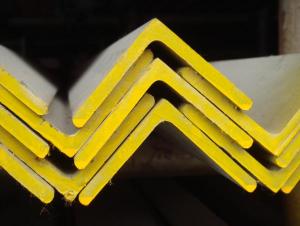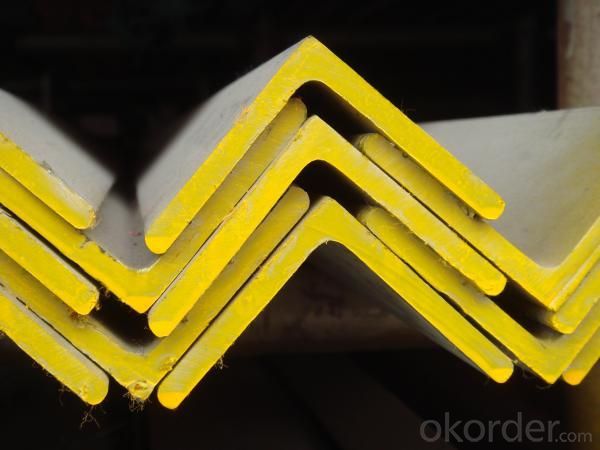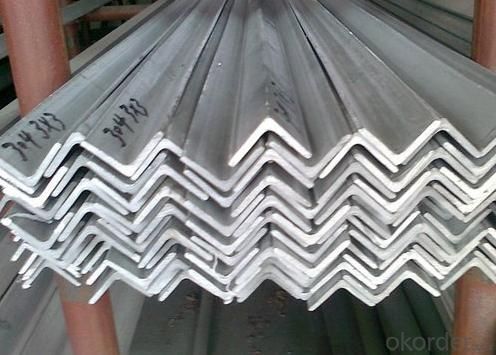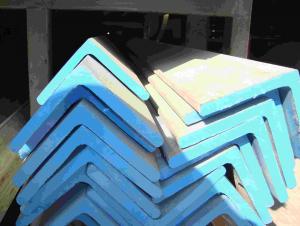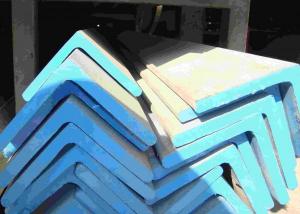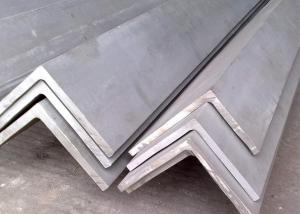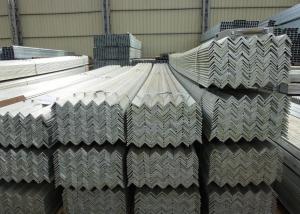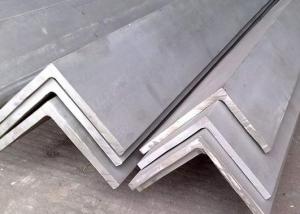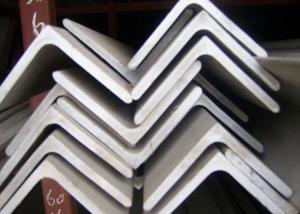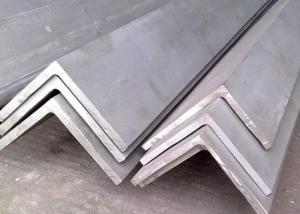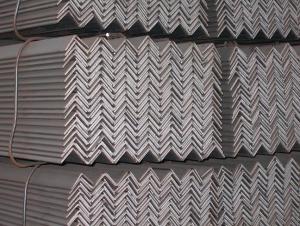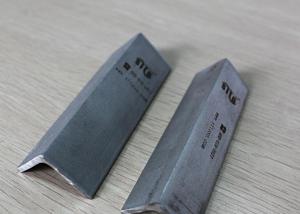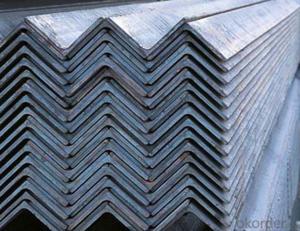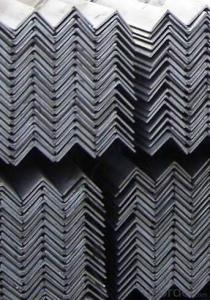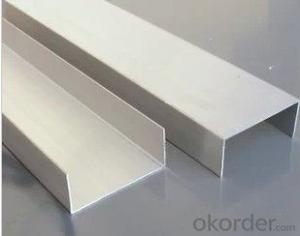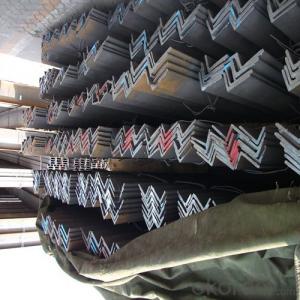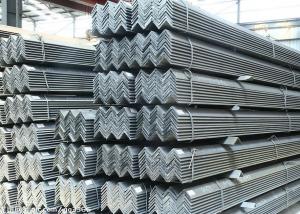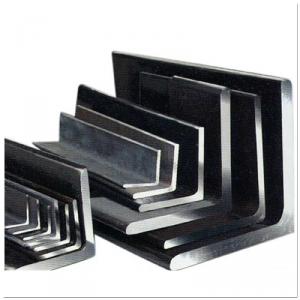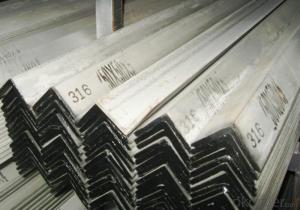Best Quality for Stainless Steel Angle Bar
- Loading Port:
- China Main Port
- Payment Terms:
- TT or LC
- Min Order Qty:
- 1 Ton m.t.
- Supply Capability:
- 500 Tons Per Month m.t./month
OKorder Service Pledge
OKorder Financial Service
You Might Also Like
General Informaiton of Stainless Steel Angle Bar
1. Grade: SS200, 300,400 series
2. Size: 25×25×3 mm-100×100×10mm
3. Process: HRAP
4. Length: 2-6m
5. Shape: Equal
6. Delivery: within 20 days
7. MOQ: 1 ton
8. Certificate: ISO 9001:2008, SGS
9. Package: Standard Export Packing, or put into wooden boxes according to your requirement
10. Application: Construction, Marine, Industry etc.
Specification of Stainless Steel Angle Bar
Name | Stainless Steel Angles | |||||
Standard | ASTM A554, A312, A249, A269 and A270 | |||||
Material Grade | 304,316,201,202, 316L,430 | |||||
Length | 6m or as customers' request | |||||
Tolerance | a) Thickness: +/-0. 15mm | |||||
b) Length: +/-4. 5mm - 0mm | ||||||
Surface | 180G, 320G, 400G Satin / Hairline(Matt Finish, Brush, Dull Finish) 400G, 500G, 600G or 800G Mirror finish | |||||
Application | Decoration construction, upholstery, industry instruments | |||||
Test | Squash test, Extended test, Water pressure test, Crystal rot test, Heat treatment, NDT | |||||
Chemical Composition of Material | Composition Material | 201 | 202 | 304 | 316 | 430 |
C | ≤0.15 | ≤0.15 | ≤0.08 | ≤0.08 | ≤0.12 | |
Si | ≤1.00 | ≤1.00 | ≤1.00 | ≤1.00 | ≤1.00 | |
Mn | 5.5-7.5 | 7.5-10 | ≤2.00 | ≤2.00 | ≤1.00 | |
P | ≤0.06 | ≤0.06 | ≤0.045 | ≤0.045 | ≤0.040 | |
S | ≤0.03 | ≤0.03 | ≤0.030 | ≤0.030 | ≤0.030 | |
Cr | 16-18 | 17-19 | 18-20 | 16-18 | 16-18 | |
Ni | 3.5-5.5 | 4-6 | 8-10.5 | 10-14 | ||
Mo | 2.0-3.0 | |||||
Mechanical Property | Material Item | 201 | 202 | 304 | 316 | |
Tensile Strength | ≥535 | ≥520 | ≥520 | ≥520 | ||
Yield Strength | ≥245 | ≥205 | ≥205 | ≥205 | ||
Extension | ≥30% | ≥30% | ≥35% | ≥35% | ||
Hardness (HV) | <253 | <253 | <200 | <200 | ||
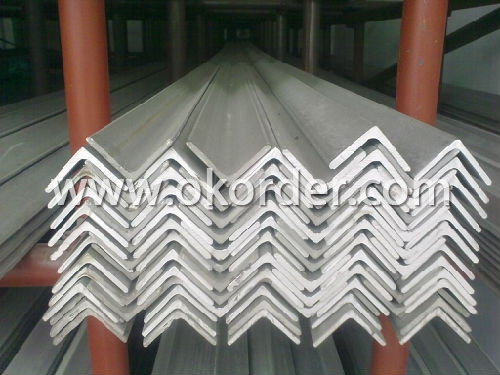
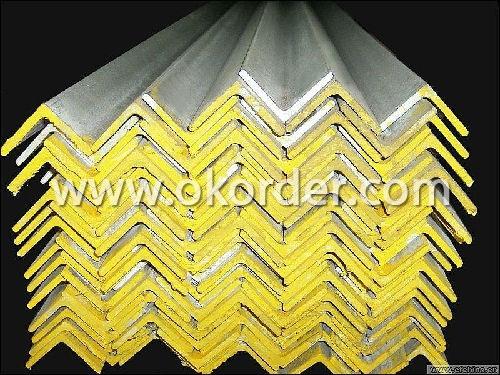
- Q: What are the different surface finishes for brushed stainless steel angles?
- There are several different surface finishes available for brushed stainless steel angles. Some of the most common finishes include: 1. Satin finish: This is a classic brushed finish that provides a smooth, matte appearance. It is achieved by brushing the stainless steel surface with a fine-grit abrasive material in a consistent linear pattern. 2. Hairline finish: This finish is similar to the satin finish but has a slightly finer texture. It is achieved by using a finer abrasive material during the brushing process, resulting in a more refined and elegant appearance. 3. Mirror finish: Also known as a polished finish, this surface treatment gives stainless steel angles a highly reflective and mirror-like appearance. It is achieved by using progressively finer abrasive materials during the polishing process until the desired level of shine is achieved. 4. Bead blasted finish: This finish involves using small glass beads or ceramic particles to blast the surface of the stainless steel angle. It creates a slightly textured matte appearance that is both visually appealing and resistant to fingerprints and scratches. 5. Linen finish: This finish is characterized by a pattern of fine parallel lines, resembling the texture of linen fabric. It is achieved by using a specialized abrasive material and a specific brushing technique to create the desired pattern. These are just a few examples of the different surface finishes available for brushed stainless steel angles. The choice of finish depends on the desired aesthetic, functionality, and the specific application of the stainless steel angles.
- Q: How do you calculate the moment of inertia of stainless steel angles?
- The moment of inertia of stainless steel angles can be calculated using the formula for the moment of inertia of a rectangular beam. This formula is I = (1/12) * b * h^3, where I is the moment of inertia, b is the base width of the angle, and h is the height of the angle. By plugging in the appropriate values for b and h, the moment of inertia of stainless steel angles can be determined.
- Q: What are the different types of stainless steel angles profiles used in interior design?
- There are several different types of stainless steel angles profiles that are commonly used in interior design. These profiles are specifically designed to provide strength, durability, and aesthetic appeal to various architectural and design applications. One common type of stainless steel angle profile used in interior design is the equal leg angle. This profile features equal length legs that intersect at a 90-degree angle, creating a square or rectangular shape. Equal leg angles are frequently used as decorative trim or edging for countertops, cabinetry, and furniture, adding a sleek and modern touch to the overall design. Another type is the unequal leg angle, which has one leg shorter than the other. This profile is often used for structural purposes, such as providing additional support or reinforcement to architectural elements like staircases, handrails, and beams. The unequal leg angle can also be utilized to create unique design features and accents in interior spaces. In addition to the equal and unequal leg angles, there are also various specialty stainless steel angle profiles available for specific design requirements. For instance, the rounded corner angle profile is designed with smooth, rounded corners, making it ideal for spaces that prioritize safety or need to prevent any sharp edges. This type of angle profile is commonly used in healthcare facilities, schools, and other public spaces. Furthermore, there are slotted angle profiles that feature strategically placed slots along the length of the angle. These slots enable easy attachment of shelves, brackets, or other accessories, making them versatile options for organizing and displaying items in interior spaces. Overall, the different types of stainless steel angle profiles used in interior design offer a wide range of possibilities for creating visually appealing and functional spaces. From equal and unequal leg angles to specialty profiles like rounded corner and slotted angles, each profile serves a specific purpose and contributes to the overall aesthetic and structural integrity of the design.
- Q: Can stainless steel angles be used in marine environments?
- Yes, stainless steel angles can be used in marine environments. Stainless steel is highly resistant to corrosion and is commonly used in marine applications due to its excellent resistance to saltwater and other corrosive elements. Stainless steel angles are often used in the construction of boats, marine equipment, and offshore structures. They provide strength and stability while maintaining their integrity in harsh marine environments. Additionally, stainless steel angles are also resistant to staining, making them a durable and reliable choice for marine applications.
- Q: How do stainless steel angles contribute to energy efficiency?
- Stainless steel angles contribute to energy efficiency by providing structural support and enhancing the insulation of buildings. These angles are commonly used in construction to reinforce walls and roofs, reducing the need for additional energy-consuming materials. Additionally, stainless steel's high thermal conductivity helps in maintaining consistent indoor temperatures, minimizing the need for excessive heating or cooling. Overall, stainless steel angles play a crucial role in improving energy efficiency by promoting sustainable construction practices and reducing energy consumption in buildings.
- Q: What are the different surface treatments for anti-corrosion stainless steel angles?
- There are several surface treatments available for anti-corrosion stainless steel angles, including passivation, electro-polishing, powder coating, and hot-dip galvanizing. Passivation involves the use of chemicals to remove impurities and create a passive oxide layer on the surface of the stainless steel, enhancing its resistance to corrosion. Electro-polishing is a similar process that removes a thin layer of material and also creates a smooth, shiny surface. Powder coating involves applying a protective layer of powdered polymer to the surface, which is then cured to create a durable and corrosion-resistant finish. Hot-dip galvanizing involves immersing the stainless steel angle in molten zinc, which forms a protective layer on the surface, providing excellent corrosion resistance. The choice of surface treatment depends on the specific application and desired level of corrosion protection.
- Q: Are stainless steel angles resistant to hydrofluoric acid?
- No, stainless steel angles are not resistant to hydrofluoric acid.
- Q: What are the ductility properties of stainless steel angles?
- Stainless steel angles exhibit excellent ductility properties, allowing them to be easily formed and shaped without the risk of cracking or breaking. This high ductility makes stainless steel angles ideal for a wide range of applications, including construction, manufacturing, and structural engineering.
- Q: How do stainless steel angles perform in high-pressure environments?
- Stainless steel angles are known for their exceptional performance in high-pressure environments. Due to their high tensile strength and resistance to corrosion, they can withstand the immense pressure exerted on them without any deformation or failure. This makes them highly suitable for applications in industries such as oil and gas, chemical processing, and marine environments, where they are frequently exposed to extreme pressures. One of the key properties of stainless steel angles is their ability to maintain their structural integrity even under high-pressure conditions. This is primarily due to their composition, which includes a significant amount of chromium and nickel. These alloying elements provide stainless steel angles with superior strength and durability, enabling them to withstand the intense pressure exerted on them without buckling or breaking. Furthermore, stainless steel angles have excellent resistance to corrosion, making them ideal for use in high-pressure environments. The chromium content in stainless steel creates a passive oxide layer on the surface, which acts as a protective barrier against corrosion. This protective layer prevents the penetration of corrosive substances, such as water, acids, and chemicals, even under high-pressure conditions. As a result, stainless steel angles can maintain their structural integrity and performance over an extended period, ensuring reliable operation in high-pressure environments. In addition to their mechanical and corrosion resistance properties, stainless steel angles offer excellent temperature resistance. They can withstand both high and low temperatures without losing their strength or structural stability. This is crucial in high-pressure environments, where extreme temperatures are often encountered, such as in steam boilers or industrial furnaces. Overall, stainless steel angles are highly reliable and perform exceptionally well in high-pressure environments. Their combination of high tensile strength, corrosion resistance, and temperature resistance make them the preferred choice for various applications, including pressure vessels, pipelines, and structural components in industries where high-pressure conditions are prevalent.
- Q: What is the standard length of stainless steel angles?
- The standard length of stainless steel angles can vary depending on the manufacturer and specific product. However, in general, stainless steel angles are commonly available in lengths ranging from 20 feet (6 meters) to 40 feet (12 meters). These lengths are often determined based on industry standards and the requirements of construction and engineering projects. It is important to note that custom lengths can also be ordered to suit specific project needs.
1. Manufacturer Overview
| Location | Jiangsu,China |
| Year Established | 2002 |
| Annual Output Value | Above US$ 8 Million |
| Main Markets | China, East Asia, |
| Company Certifications | ISO9001:2000; |
2. Manufacturer Certificates
| a) Certification Name | |
| Range | |
| Reference | |
| Validity Period |
3. Manufacturer Capability
| a) Trade Capacity | |
| Nearest Port | Shanghai |
| Export Percentage | 40% |
| No.of Employees in Trade Department | 30 People |
| Language Spoken: | English;Chinese |
| b) Factory Information | |
| Factory Size: | Above 26,000 square meters |
| No. of Production Lines | Above 6 |
| Contract Manufacturing | OEM Service Offered;Design Service Offered |
| Product Price Range | Average |
Send your message to us
Best Quality for Stainless Steel Angle Bar
- Loading Port:
- China Main Port
- Payment Terms:
- TT or LC
- Min Order Qty:
- 1 Ton m.t.
- Supply Capability:
- 500 Tons Per Month m.t./month
OKorder Service Pledge
OKorder Financial Service
Similar products
Hot products
Hot Searches
Related keywords
